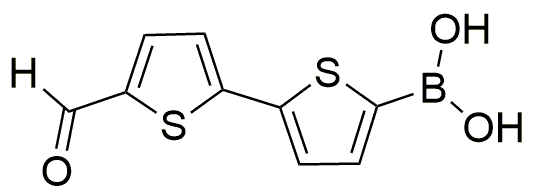5'-Formyl-2,2'-bithiophene-5-boronic acid is widely utilized in research focused on:
- Organic Electronics: This compound is used in the development of organic semiconductors, which are crucial for creating flexible and lightweight electronic devices such as OLEDs (Organic Light Emitting Diodes) and organic solar cells. Its unique structure enhances charge transport properties.
- Sensor Technology: It serves as a key component in the fabrication of chemical sensors. The compound's ability to form stable complexes with various analytes makes it ideal for detecting environmental pollutants or biological markers.
- Pharmaceutical Research: In medicinal chemistry, it acts as a building block for synthesizing new drug candidates. Its boronic acid functionality allows for selective reactions, facilitating the development of targeted therapies.
- Material Science: The compound is employed in creating advanced materials with tailored properties, such as conducting polymers. These materials find applications in batteries and supercapacitors, improving energy storage solutions.
- Photovoltaic Applications: It is also used in the design of novel photovoltaic materials, enhancing the efficiency of solar cells. The compound's ability to absorb light at specific wavelengths contributes to better energy conversion rates.
General Information
Properties
Safety and Regulations
Applications
5'-Formyl-2,2'-bithiophene-5-boronic acid is widely utilized in research focused on:
- Organic Electronics: This compound is used in the development of organic semiconductors, which are crucial for creating flexible and lightweight electronic devices such as OLEDs (Organic Light Emitting Diodes) and organic solar cells. Its unique structure enhances charge transport properties.
- Sensor Technology: It serves as a key component in the fabrication of chemical sensors. The compound's ability to form stable complexes with various analytes makes it ideal for detecting environmental pollutants or biological markers.
- Pharmaceutical Research: In medicinal chemistry, it acts as a building block for synthesizing new drug candidates. Its boronic acid functionality allows for selective reactions, facilitating the development of targeted therapies.
- Material Science: The compound is employed in creating advanced materials with tailored properties, such as conducting polymers. These materials find applications in batteries and supercapacitors, improving energy storage solutions.
- Photovoltaic Applications: It is also used in the design of novel photovoltaic materials, enhancing the efficiency of solar cells. The compound's ability to absorb light at specific wavelengths contributes to better energy conversion rates.
Documents
Safety Data Sheets (SDS)
The SDS provides comprehensive safety information on handling, storage, and disposal of the product.
Product Specification (PS)
The PS provides a comprehensive breakdown of the product’s properties, including chemical composition, physical state, purity, and storage requirements. It also details acceptable quality ranges and the product's intended applications.
Certificates of Analysis (COA)
Search for Certificates of Analysis (COA) by entering the products Lot Number. Lot and Batch Numbers can be found on a product’s label following the words ‘Lot’ or ‘Batch’.
Número de catálogo
Número de lote/lote
Certificates Of Origin (COO)
This COO confirms the country where the product was manufactured, and also details the materials and components used in it and whether it is derived from natural, synthetic, or other specific sources. This certificate may be required for customs, trade, and regulatory compliance.
Número de catálogo
Número de lote/lote
Safety Data Sheets (SDS)
The SDS provides comprehensive safety information on handling, storage, and disposal of the product.
DownloadProduct Specification (PS)
The PS provides a comprehensive breakdown of the product’s properties, including chemical composition, physical state, purity, and storage requirements. It also details acceptable quality ranges and the product's intended applications.
DownloadCertificates of Analysis (COA)
Search for Certificates of Analysis (COA) by entering the products Lot Number. Lot and Batch Numbers can be found on a product’s label following the words ‘Lot’ or ‘Batch’.
Número de catálogo
Número de lote/lote
Certificates Of Origin (COO)
This COO confirms the country where the product was manufactured, and also details the materials and components used in it and whether it is derived from natural, synthetic, or other specific sources. This certificate may be required for customs, trade, and regulatory compliance.

